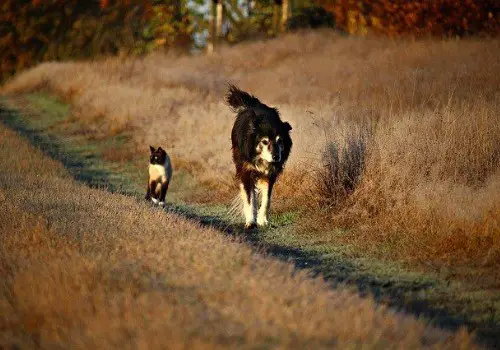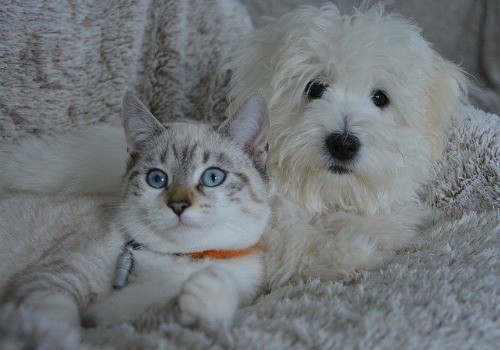It’s a sad fact of pet ownership: our furry friends aren’t going to be around forever.
The best we can do is enjoy the happy years we have with our cats and dogs — and provide them with as much comfort as we can when old age catches up with them.
But there’s a pretty significant discrepancy between the average lifespans of a cat and that of a dog.
On average, cats live between 12 and 18 years, with many reaching their 20s. The average age of a cat at time of death is 15.
On the other hand, dogs have an average lifespan of just 8 to 11 years. Larger dogs fall on the lower end of the spectrum, while smaller breeds tend to live longer.
For example, the world’s tallest dog, Zeus, was a 155-pound, 3.6-foot-tall Great Dane who died at age 5 after showing “old age symptoms” for some time.
However, none of the world’s five oldest dogs, all well over 27 years old, weighed over 40 pounds.
So what’s the reason behind these big differences? Why do cats live longer than dogs, and why do small dogs outlive large dogs?
The answers lie ahead… read on!
Size and Lifespan in the Wild

In the animal kingdom, size matters when it comes to lifespan.
It’s a rule that holds true across the vast majority of species out there: the smaller the animal, the shorter the lifespan.
African elephants, for example, live an average of 56 years in the wild.
The average lifespan of a wild zebra is 25 years.
And the petite elephant shrew lives just 2 to 4 years in the wild.
The inverse correlation between size and lifespan is clear. And the underlying reasoning has a lot to do with heart rate.
An elephant’s massive heart beats just 30 times per minute.
Shrews, meanwhile, hold the record for fastest heart rate in a warm-blooded animal. They average 835 beats per minute, with the highest recorded heart rate clocking in at a whopping 1,511 beats per minute.
Studies suggest that a mammal’s heart lasts around 1 billion beats before giving out. The faster those beats are used up, the shorter the animal’s lifespan.
So it makes sense that shrews exhaust their hearts in just a few years, while elephants live longer by keeping their heart rate slow and steady.
But that only raises more questions about cats and dogs.
Cats and Dogs: Reversing the Equation

Cats tend to be smaller than dogs. Many dogs are ten times larger than cats, but the larger the dog, the shorter it lives.
Yet large dogs have an average heart rate of 60 to 100 beats per minute, while small dogs average around 100 to 140 beats per minute.
And a cat’s heart rate ranges between 140 and 220 beats per minute, depending on its level of relaxation.
That’s in line with what we see in the rest of the animal kingdom.
So why does a dog’s heart rate, which averages fewer beats per minute than cats, have the opposite effect on its lifespan?
To answer that, we’ll need to look beyond heart rate and compare the evolution of domestic cats and dogs.
A Long, Lonely Life for Cats

One theory is that cats live longer than dogs because of their solitary lifestyle.
The theory goes that the less an animal interacts with others, the safer it is. And the safer it is, the longer it lives.
It’s a theory that checks out when you look at the behavioral differences between cats and dogs.
Dogs tend to be a lot more social than cats. Playtime never ends in homes with multiple dogs, but even solo pups spend plenty of time interacting with others at doggy daycare or the dog park.
Meanwhile, two cats can share a home and barely acknowledge each other’s presence. And there’s a reason you don’t see any “cat parks” around: the cats would probably either fight or ignore each other.
But a cat’s drive to be alone is likely a huge contributor to its longer lifespan.
Less socializing means less chance of coming into contact with a sick cat, who could pass on deadly illnesses. And a cat’s razor-sharp claws and teeth tell predators to stay far away.
Between its attitude and its physical weaponry, the cat seems perfectly designed to ward off both friend and foe.
The same can’t be said for dogs, for whom socializing is a fundamental part of life.
But with increased socialization comes an increased risk of harm.
Even if two perfectly healthy dogs get together, their roughhousing can result in scratches, bites and other injuries. Open wounds leave dogs susceptible to infection, which weakens the immune system and can lead to many other health problems.
This could help to account for the general difference between cat and dog lifespans.
Designer Dogs, Decreased Lifespans

Another factor in the shorter lifespan of dogs is probably us.
Over the years since domestication, humans have altered dogs in ways that far surpass anything we’ve done to cats.
Most breeds of cat look very similar, and while there are different sizes and shapes, they don’t vary near as much as dogs do.
Meanwhile, dogs can weigh as little as 3 pounds or as much as 200. Different breeds have vastly different builds, coats, features, and personalities.
We’ve bred dogs to be so different on purpose. We enjoy the wide variety of breeds and the different characteristics they bring to the table, but these differences have likely come at the cost of the species’ health.
Genes interact with one another in unpredictable ways, many of which we’re not even aware of yet. By breeding dogs to emphasize certain features, we’ve also been unintentionally emphasizing health conditions that shorten dogs’ lifespans.
Take the Cavalier King Charles Spaniel, for example. We’ve spent hundreds of years breeding it for silkier fur and floppier ears, the features that give the breed much of its appeal.
But in the process, we’ve been breeding it for early onset heart and brain problems that lead to premature death.
50% of Cavaliers develop mitral valve heart disease by age five, and 70% develop canine syringomyelia, a neurological disorder, by the same age.
Larger dogs have it even worse. We’re not entirely sure of the root cause yet, but it appears that as we’ve bred dogs to be bigger, we’ve also bred them to age faster.
One possible explanation: large breed puppies grow much faster than small-breed puppies, which results in higher concentrations of oxygen free radicals — byproducts of high metabolism.
These molecules deplete the body of antioxidants and damage cells, leading to cancer and other diseases. Cell damage in puppyhood has dramatic effects on future health and lifespan, and it seems that large breed puppies are more susceptible to it.
More research is needed, but it’s possible that antioxidant supplements given to large breed puppies could help to extend their lifespans.
For now, though, small dogs will continue to outlive big dogs, and cats will continue to outlive them both.
It’s a strange, unintended consequence of domestication and selective breeding, one that breeders will need to seriously consider when playing with genetics.

